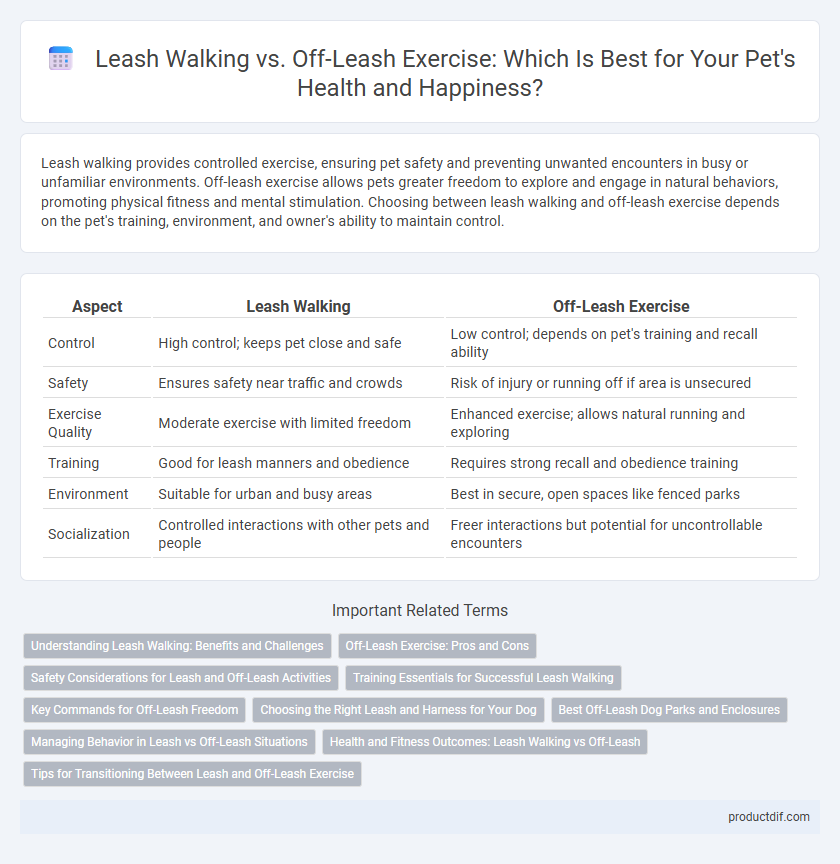Leash walking provides controlled exercise, ensuring pet safety and preventing unwanted encounters in busy or unfamiliar environments. Off-leash exercise allows pets greater freedom to explore and engage in natural behaviors, promoting physical fitness and mental stimulation. Choosing between leash walking and off-leash exercise depends on the pet's training, environment, and owner's ability to maintain control.
Table of Comparison
| Aspect | Leash Walking | Off-Leash Exercise |
|---|---|---|
| Control | High control; keeps pet close and safe | Low control; depends on pet's training and recall ability |
| Safety | Ensures safety near traffic and crowds | Risk of injury or running off if area is unsecured |
| Exercise Quality | Moderate exercise with limited freedom | Enhanced exercise; allows natural running and exploring |
| Training | Good for leash manners and obedience | Requires strong recall and obedience training |
| Environment | Suitable for urban and busy areas | Best in secure, open spaces like fenced parks |
| Socialization | Controlled interactions with other pets and people | Freer interactions but potential for uncontrollable encounters |
Understanding Leash Walking: Benefits and Challenges
Leash walking offers pet owners greater control and safety, preventing dogs from running into traffic or encountering aggressive animals. This controlled environment aids in training behaviors like heel, sit, and stay, reinforcing obedience and discipline during walks. However, leash walking may limit a dog's natural movement and social interactions, potentially causing frustration or anxiety if sessions are too restrictive or frequent.
Off-Leash Exercise: Pros and Cons
Off-leash exercise offers dogs greater freedom to explore and burn energy naturally, which can enhance their physical fitness and mental stimulation. However, it requires a secure, designated area to prevent risks such as traffic accidents, wildlife encounters, or lost pets. Owners must ensure strong recall training and local regulations compliance to maximize safety and enjoyment during off-leash activities.
Safety Considerations for Leash and Off-Leash Activities
Leash walking ensures controlled interactions and minimizes risks such as traffic accidents, wildlife encounters, and loss of pet, making it crucial in urban or high-traffic areas. Off-leash exercise offers pets greater freedom and physical stimulation but demands secure, fenced environments and reliable recall training to prevent injuries or conflicts with other animals. Prioritizing safety gear like reflective collars, harnesses, and GPS trackers enhances protection during both leash and off-leash activities.
Training Essentials for Successful Leash Walking
Effective leash walking training essentials include consistent reinforcement of commands such as "heel," "sit," and "stay" to maintain control and encourage good behavior. Using a sturdy, comfortable leash and well-fitted harness or collar ensures safety and prevents injury during walks. Regular, short training sessions combined with positive reinforcement techniques enhance a dog's focus and reliability while on a leash.
Key Commands for Off-Leash Freedom
Key commands such as "come," "stay," and "heel" are essential for off-leash exercise to ensure pet safety and control. Consistent obedience training reinforces these commands, enabling dogs to respond reliably in various environments. Proper use of key commands enhances the benefits of off-leash freedom while minimizing risks during outdoor activities.
Choosing the Right Leash and Harness for Your Dog
Selecting the right leash and harness depends on your dog's size, temperament, and exercise needs to ensure safety and comfort during walks or off-leash activities. Opt for a sturdy, adjustable harness that prevents pulling and distributes pressure evenly, reducing strain on your dog's neck. Reflective materials and durable clips enhance visibility and durability, making your pet's outdoor experience secure and enjoyable.
Best Off-Leash Dog Parks and Enclosures
Best off-leash dog parks and enclosures provide a safe, controlled environment for dogs to exercise freely while promoting socialization and physical health. These areas are typically fenced with secure gates, ample space, and dog-friendly amenities such as water stations and shaded rest zones. Choosing well-maintained off-leash parks supports better behavioral outcomes and offers pet owners peace of mind during their dog's off-leash activities.
Managing Behavior in Leash vs Off-Leash Situations
Managing behavior during leash walking involves consistent reinforcement of commands and controlled exposure to distractions, which helps dogs learn boundaries and focus. Off-leash exercise demands reliable recall skills and a strong bond between owner and pet to ensure safety and prevent unwanted behaviors like chasing or aggression. Proper training in both environments enhances obedience and promotes balanced socialization, offering pets structured freedom and mental stimulation.
Health and Fitness Outcomes: Leash Walking vs Off-Leash
Leash walking provides controlled exercise that helps maintain consistent cardiovascular activity and can reduce the risk of injuries by limiting sudden sprints or abrupt movements. Off-leash exercise encourages more dynamic movement patterns, boosting muscle strength, agility, and mental stimulation through natural exploration and running. Both methods contribute to overall pet health, but balancing leash walking with supervised off-leash time maximizes fitness outcomes and behavioral benefits.
Tips for Transitioning Between Leash and Off-Leash Exercise
When transitioning between leash walking and off-leash exercise, gradually introduce your pet to open spaces while maintaining control with a long leash to ensure safety. Use positive reinforcement to reward recalls and responsiveness, building trust and reliable obedience before fully removing the leash. Consistent practice in varied environments helps pets adapt smoothly, enhancing both freedom and safety during their active playtime.
Leash Walking vs Off-Leash Exercise Infographic

 productdif.com
productdif.com